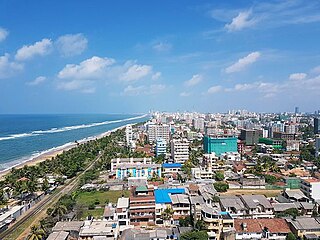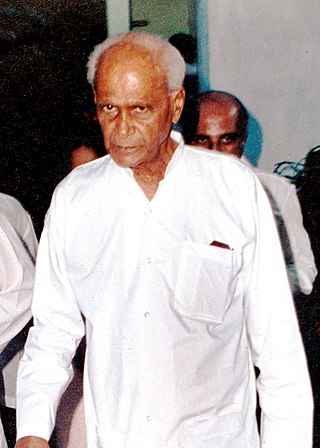
Richmond College is a primary and secondary school in Galle, Sri Lanka which was established as Galle High School in 1876. The founder of school was the Wesleyan Missionary George Bough. The first principal of the school was Rev Samuel Langdon. In 1882, it was renamed Richmond College. Richmond College is the first Wesleyan Methodist school to be established in Asia. The former school of Richmond College known as the 'Galle School' dates back to July 1814.

Batticaloa is a major city in the Eastern Province, Sri Lanka, and its former capital. It is the administrative capital of the Batticaloa District. The city is the seat of the Eastern University of Sri Lanka and is a major commercial centre. It is on the east coast, 111 kilometres (69 mi) south of Trincomalee, and is situated on an island. Pasikudah is a popular tourist destination situated 35 km (22 mi) northwest with beaches and flat year-round warm-water shallow-lagoons.

Southlands College is a girls' school located in Galle, Sri Lanka, founded in 1885 by the Wesleyan Methodist missionaries. Southlands College is situated within the historical Galle fort.

Dehiwala-Mount Lavinia, population 245,974 (2012), is a large municipality in Sri Lanka, covering 2,109 ha. It lies south of the Colombo Municipal Council area and is separated from it by the Dehiwala canal which forms the northern boundary of DMMC. Its southern limits lie in Borupana Road and the eastern boundary is Weras Ganga with its canal system and it includes some areas to its east. This town has experienced extensive population growth and rapid industrialisation and urbanisation in recent years. It is home to Sri Lanka's National Zoological Gardens, which remains one of Asia's largest. Colombo South Teaching Hospital, Kalubowila and Colombo Airport, Ratmalana are some important landmarks in this area. Dehiwela-Mount Lavinia and Sri Jayawardenapura Kotte being two large suburban centres of the city of Colombo function together as one large urban agglomeration in the Region. The overspill from the City in residential and commercial uses of land has rapidly urbanised these suburban centres. Dehiwela-Mount Lavinia and Sri Jayawardenpaura along with Colombo Municipal Council form the most urbanised part of the core area of the Colombo Metropolitan Region. Dehiwala and Mount Lavinia lie along the Galle Road artery, which runs along the coast to the south of the country.

Wijeyananda Dahanayake was a Sri Lankan politician. He was the Prime Minister of Ceylon from September 1959 to March 1960.

Wesley College, Colombo, popularly known as "Wesley" or "The Double Blues" is a Methodist school providing primary and secondary education in Sri Lanka since 1874.
Moratuwa is a large municipality in Sri Lanka, on the southwestern coast of Sri Lanka, near Dehiwala-Mount Lavinia. It is situated on the Galle–Colombo main highway, 18 km (11 mi) south of the centre of Colombo. Moratuwa is surrounded on three sides by water, except in the north of the city, by the Indian Ocean on the west, the Lake Bolgoda on the east and the Moratu river on the south. According to the 2012 census, the suburb had a population of 168,280.
Newstead Girls' College, Negombo is the oldest existing girls' college and the third oldest public school in Sri Lanka, founded by Wesleyan ministers in 1815-1816. Asia's first girls' school.

Hartley College is a provincial school in Point Pedro, Sri Lanka. Founded in 1838 by British Methodist missionaries, it is one of Sri Lanka's oldest schools. The school is named after Wesleyan priest and missionary Rev. Hartley.

Jaffna Central College is a national school in Jaffna, Sri Lanka. Founded in 1816 by British Methodist missionaries, it is one of Sri Lanka's oldest schools.

Dr. Cristopher William Wijekoon Kannangara was a Sri Lankan Lawyer and a politician. He rose up the ranks of Sri Lanka's movement for independence in the early part of the 20th century. As a lawyer he defended the detainees that were imprisoned during the Riots of 1915, many of whom were the emerging leaders of the independence movement. In 1931, he became the President of Ceylon National Congress, the forerunner to the United National Party. Later, he became the first Minister of Education in the State Council of Ceylon, and was instrumental in introducing extensive reforms to the country's education system that opened up education to children from all levels of society.

The American Ceylon Mission (ACM) to Jaffna, Sri Lanka started with the arrival in 1813 of missionaries sponsored by the American Board of Commissioners for Foreign Missions (ABCFM). Although they had originally planned to work in Galle, the British colonial office in Ceylon restricted the Americans to out-of-the-way Jaffna due to the security concerns of the British who were warring with France at the time. The critical period of the impact of the missionaries was from the 1820s to early 20th century. During this time, they engaged in original translations from English to Tamil, printing, and publishing, establishing primary, secondary and tertiary educational institutions and providing health care for residents of the Jaffna Peninsula. These activities resulted in many social changes amongst Sri Lankan Tamils that survive even today. They also led to the attainment of a lopsided literacy level among residents in the relatively small peninsula that is cited by scholars as one of the primary factors contributing to the recently ended civil war. Many notable educational and health institutions within the Jaffna Peninsula owe their origins to the missionary activists from America. Missionaries also courted controversy by publishing negative information about local religious practices and rituals.

The Church of Ceylon is the Anglican Church in Sri Lanka. It is an extraprovincial jurisdiction of the Archbishop of Canterbury, who serves as its Metropolitan. It was established in 1845 with the appointment of the first Anglican Bishop of Colombo, James Chapman and until 1950 it consisted of a single diocese; in that year a second diocese was established at Kurunegala.

Vembadi Girls’ High School is a national school in Jaffna, Sri Lanka. Founded in 1834 by British Methodist missionaries, it is one of Sri Lanka's oldest schools.

Methodist Central College is a provincial school in Batticaloa, Sri Lanka.
The Methodist Church of Sri Lanka is a Protestant Christian denomination in Sri Lanka. Its headquarters is in Colombo and was established on 29 June 1814. It is a member of the World Council of Churches, the Christian Conference of Asia, the National Christian Council of Sri Lanka and the World Methodist Council.
Rippon College is the oldest girls' school in Southern Province, Sri Lanka. The school was established in 1817 by the Rev. John McKenny as the female branch or department of the 2nd Wesleyan English School in Ja koratuwa, Megalle, Galle in 1817.Methodist missionaries at Richmond Hill, Galle. At the beginning the school was the Galle Girls' School. in 1857, the school was moved to Richmond Hill along with Galle School and several branch schools and was called the Richmond Hill Girls' Boarding school. In 1876, the Rev George Baugh separated it from the boys' school and renamed it as the Whitfield Road School for Girls, and later it was again renamed in honour of the Rev. Joseph Rippon who founded the Richmond Hill circuit and served as the Superintendent Missionary of Galle in Ceylon during the period of 1850 to 1860. The school presently provides primary and secondary education to girls aged 6 to 19 and has a student population of around 2,550.
Randles Hill is a hill located in the suburb of Mulgampola in Kandy, Sri Lanka.

Methodist Church in Pettah is a Methodist church situated in Colombo, Sri Lanka. It is considered as the first Methodist church, established in Sri Lanka as well as Asia. The church building has been formally recognised by the Government as an archaeological protected monument in Sri Lanka. The designation was declared on 17 May 2013 under the government Gazette number 1811.















